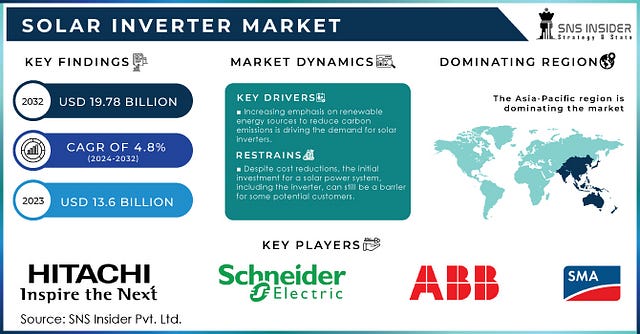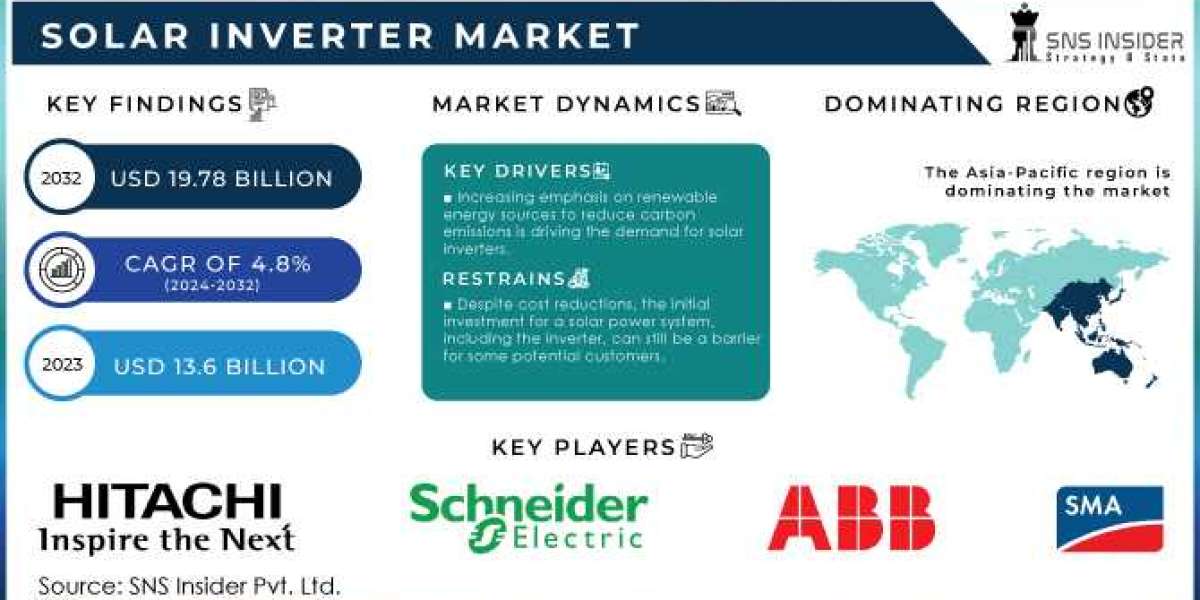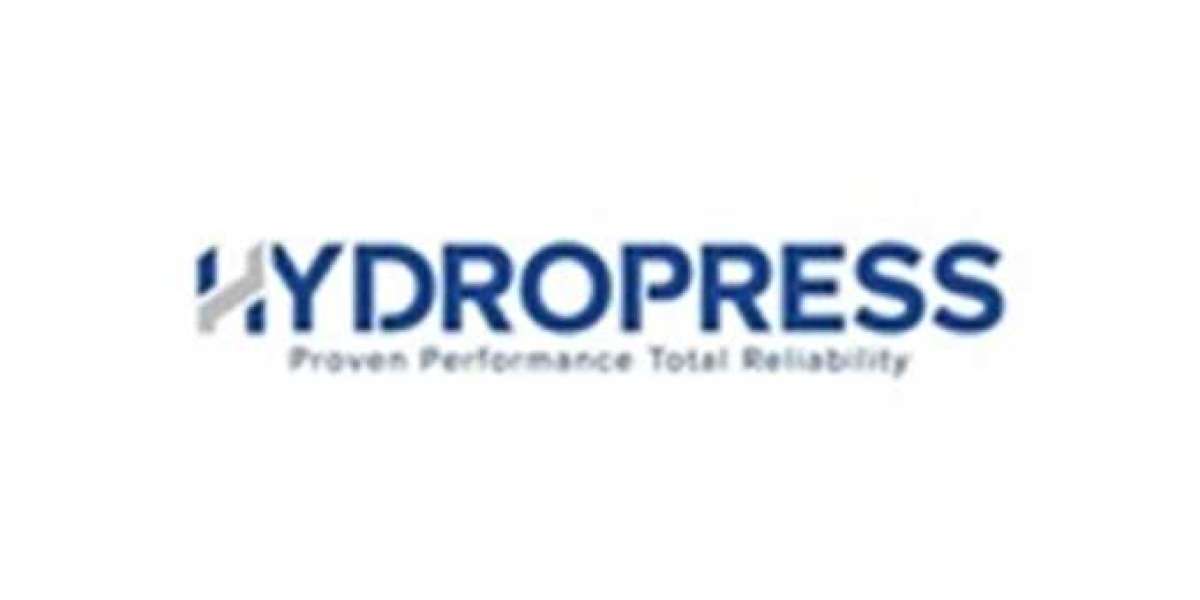
The Solar Inverter Market Size was valued at $13.6 billion in 2023 and is expected to reach $19.78 billion by 2032 and grow at a CAGR of 4.8% by 2024–2032.
The Solar Inverter Market is poised for robust growth during the forecast period, driven by the increasing adoption of solar energy across residential, commercial, and utility sectors. Solar inverters play a vital role in solar power systems by converting direct current (DC) electricity generated by solar panels into alternating current (AC) electricity for use in homes, businesses, and power grids.
Market Segmentation
By Type
Central Inverter:
- These inverters are designed for large-scale solar installations, particularly in utility-scale projects. Central inverters handle high power output, making them ideal for large solar farms and commercial solar systems.
Micro Inverter:
- Micro inverters are typically used in residential systems, where each solar panel is equipped with its own inverter. This setup allows for higher energy output by optimizing the performance of each panel individually, even in partially shaded conditions.
String Inverter:
- Commonly used in both residential and commercial systems, string inverters connect multiple solar panels (a “string”) to a single inverter. They offer a good balance between cost and efficiency.
By System Type
On-Grid:
- On-grid solar inverters are connected to the public electricity grid. These systems allow users to sell excess power back to the grid through net metering. On-grid systems are widely used in urban and suburban areas.
Off-Grid:
- Off-grid solar inverters are used in systems that operate independently from the grid. These inverters are often paired with battery storage systems to ensure a continuous power supply, making them ideal for remote locations and areas without reliable grid access.
By Phase
Single-Phase:
- Single-phase inverters are typically used in residential applications where power requirements are relatively low. They provide reliable energy conversion for homes and small businesses.
Three-Phase:
- Three-phase inverters are used in larger installations, such as commercial buildings and industrial facilities. They handle higher power loads efficiently and are commonly used in utility-scale solar farms.
By Application
Residential:
- The residential segment is expected to see significant growth as more homeowners adopt solar energy to reduce electricity bills and carbon footprints. Micro and string inverters dominate this segment due to their compatibility with small-scale systems.
Commercial:
- The commercial sector is adopting solar power for cost savings and sustainability goals. String and central inverters are widely used for medium to large-scale commercial solar systems.
Utilities:
- The utilities segment represents the largest market share due to the increasing number of large-scale solar farms. Central inverters are the preferred choice for these high-capacity projects due to their ability to manage large amounts of solar power efficiently.
By Region
North America:
- The region is expected to witness substantial growth, particularly in the U.S. and Canada, driven by government incentives and the rising demand for clean energy. On-grid systems dominate the market in this region.
Europe:
- Europe is a mature market for solar inverters, with countries like Germany, Spain, and Italy leading in solar power adoption. String and central inverters are widely used, supported by favorable government policies and ambitious renewable energy targets.
Asia-Pacific:
- Asia-Pacific is the fastest-growing market, led by China, India, and Japan. Rapid urbanization, increasing energy demand, and strong government support for solar power are key drivers. Central inverters dominate utility-scale projects, while residential and commercial sectors prefer string and micro inverters.
Latin America:
- Countries like Brazil and Mexico are investing heavily in solar energy to diversify their energy mix. On-grid and central inverters are gaining popularity in utility-scale projects, while residential and commercial segments see growing adoption of string inverters.
Middle East Africa (MEA):
- The MEA region is witnessing growth in solar energy adoption, particularly in the UAE, Saudi Arabia, and South Africa. The focus on renewable energy projects and the availability of abundant sunlight are driving demand for solar inverters, especially central and string inverters in utility-scale applications.
Market Drivers
- Rising Demand for Renewable Energy:
- Governments and organizations worldwide are focusing on reducing carbon emissions and adopting renewable energy sources, which is boosting the solar inverter market.
- Government Incentives and Policies:
- Subsidies, tax credits, and favorable policies are encouraging the adoption of solar energy systems, leading to increased demand for solar inverters.
- Declining Costs of Solar Systems:
- The decreasing cost of solar panels and related equipment, including inverters, is making solar energy more accessible and affordable.
- Technological Advancements:
- Innovations in inverter technology, such as smart inverters with enhanced grid-support functionalities, are driving market growth. These inverters enable better monitoring and management of solar systems.
Challenges
- High Initial Costs:
- Despite declining costs, the upfront investment for solar energy systems can be a barrier for some consumers.
- Grid Integration Issues:
- In regions with outdated grid infrastructure, integrating solar systems can be challenging, potentially impacting inverter performance.
- Maintenance and Reliability:
- Ensuring the long-term reliability and efficiency of solar inverters, especially in harsh environmental conditions, remains a concern for manufacturers and users.
Market Outlook
The global solar inverter market is projected to grow significantly between 2024 and 2032, driven by increased solar power adoption and advancements in inverter technology. The utility sector will remain the largest application segment, while the residential sector will see rapid growth due to rising awareness and government support.
Key Trends:
- Increasing adoption of hybrid inverters that can handle solar, battery storage, and grid connections.
- Growth in microgrid applications, particularly in remote and off-grid areas.
- Expansion of smart inverters that offer enhanced monitoring and grid-support functionalities.
Read Complete Report Details of Solar Inverter Market 2024–2032@ https://www.snsinsider.com/reports/solar-inverter-market-1343
About Us:
SNS Insider is a global leader in market research and consulting, shaping the future of the industry. Our mission is to empower clients with the insights they need to thrive in dynamic environments. Utilizing advanced methodologies such as surveys, video interviews, and focus groups, we provide up-to-date, accurate market intelligence and consumer insights, ensuring you make confident, informed decisions.
Contact Us:
Akash Anand — Head of Business Development Strategy
info@snsinsider.com
Phone: +1–415–230–0044 (US) | +91–7798602273 (IND)











